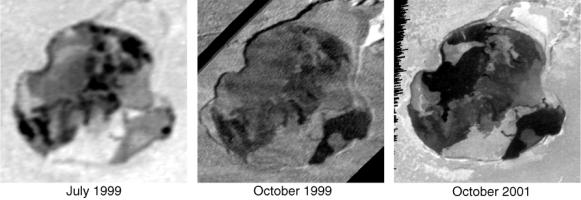This image taken by NASA's Galileo spacecraft reveals fresh lava in a wide pit named Gish Bar Patera on Jupiter's moon Io.The patera, or depression, is quite large: 106.3 kilometers (66 miles) by 115.0 kilometers (71 miles). Galileo has detected volcanic activity at this site in the past, particularly in late 1996.
Galileo took this image on Oct. 16, 2001, during its 32nd orbit of Jupiter. Effects of a new eruption at Gish Bar can be seen in a comparison with images from 1999 (see figure below). The new eruption was first detected in infrared imaging by Galileo's near-infrared mapping spectrometer in August 2001. This visible-light image shows a pair of new lava flows. The largest runs to the western boundary and extends to the central and northern portions of the patera. The other flow corresponds to a secondary depression in the southeastern portion of the patera. Based on changes seen at this depression between July and October 1999, this is thought to be the site of an outburst seen by Earth-based observers in August 1999.

Gish Bar Patera lies at the base of an 11-kilometer (36,000-foot) mountain at 15.6 degrees north latitude, 89.1 degrees west longitude on Io. This image was taken from a distance of 25,000 kilometers (15,500 miles) and has a resolution of 250 meters (820 feet) per pixel. The Sun is straight behind the observer, an illumination angle that minimizes shadows and emphasizes inherent brightness variations rather than topography.
The Jet Propulsion Laboratory, a division of the California Institute of Technology in Pasadena, manages the Galileo mission for NASA's Office of Space Science, Washington, D.C. Additional information about Galileo and its discoveries is available on the Galileo mission home page at http://solarsystem.nasa.gov/galileo/. Background information and educational context for the images can be found at http://galileo.jpl.nasa.gov/gallery/io.cfm.

